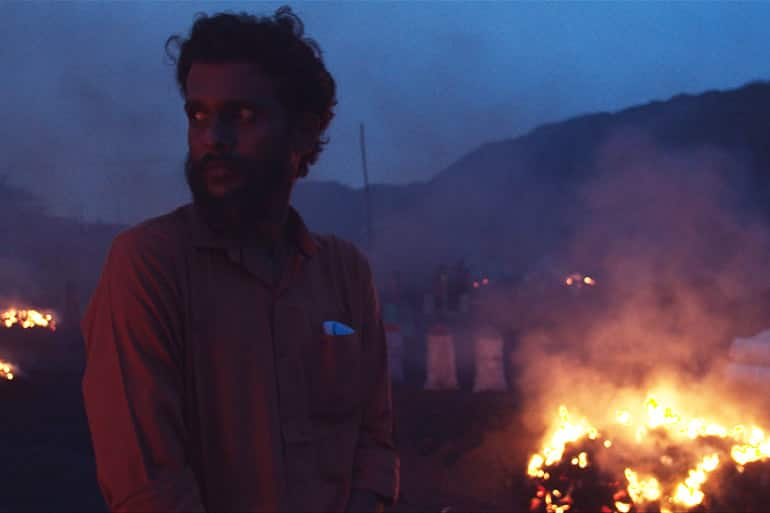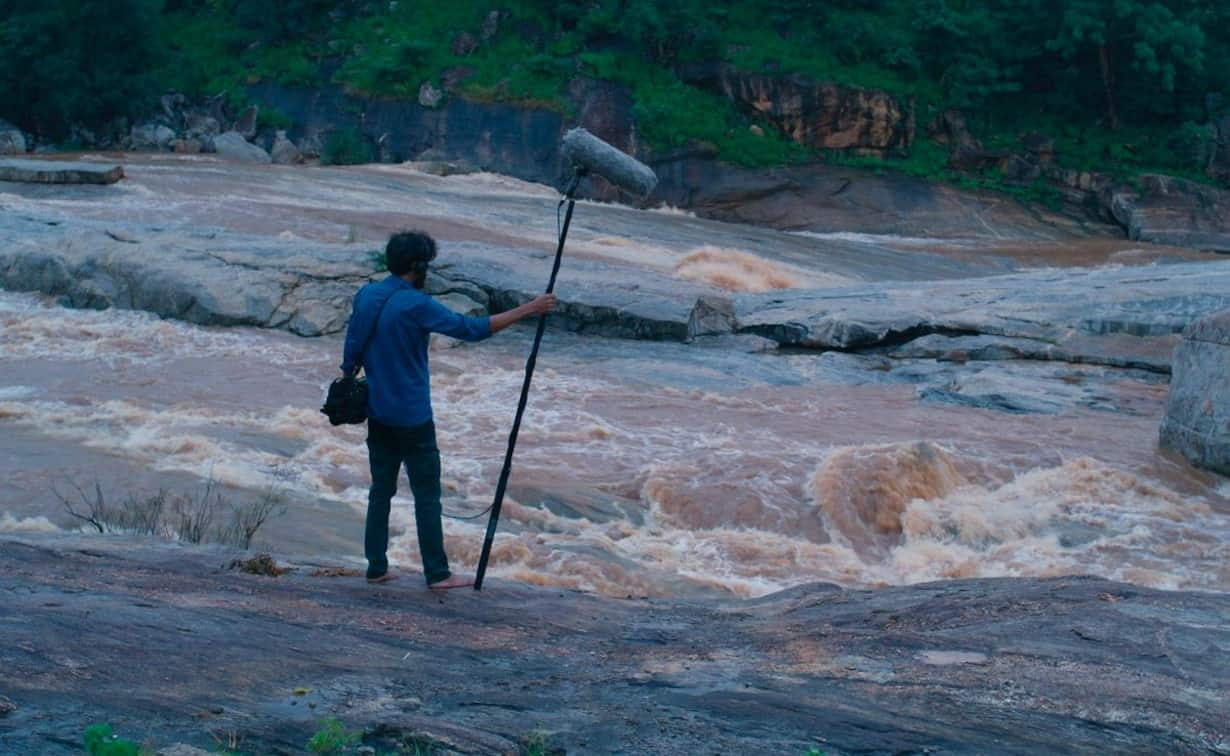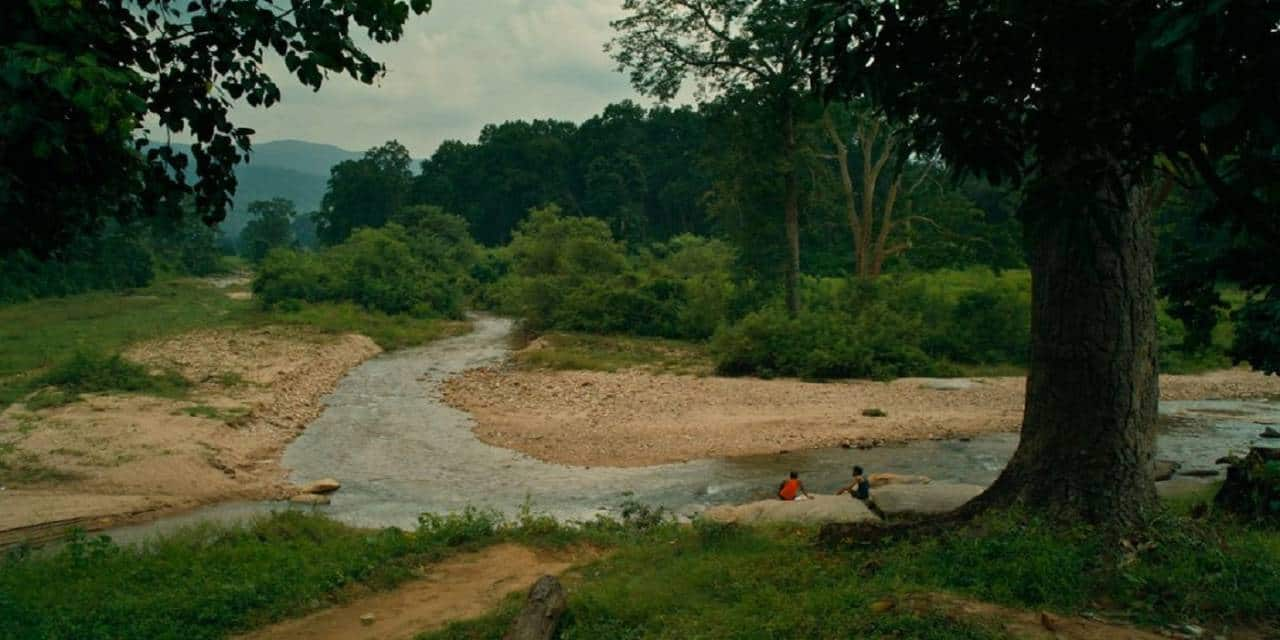



As Hindi cinema's interest in the lives of miners in eastern India’s coalfields revives with Mission Raniganj: The Great Bharat Rescue (in which Akshay Kumar plays the ‘mining rescue expert’ Jaswant Singh Gill), it harks back to the days Yash Chopra made Amitabh Bachchan atone for a past guilt by sticking it out in the claustrophobic black holes rescuing fellow miners in Kaala Patthar (1979) while chanting: “My pain is my destiny and I can’t avoid it”. Between these two films came Lubdhak Chatterjee’s Whispers of Fire & Water, which premiered at the Locarno International Film Festival this August.
Of course, Chatterjee's observational and experiential film is devoid of any hero-worshipping, saviour complex, rescue missions and hyperbolic titles. Chatterjee's protagonist is a lanky, weak, city-bred creature who undergoes an internal turmoil in this stark landscape.
Shiva (Sagnik Mukherjee) is an audio artist, who goes to Jharkhand’s Jharia coal mines (run by Coal India subsidiary Bharat Coking Coal Ltd). There, he is to record the sounds to bring back to Kolkata, for an art installation. Commerce and art both profiteers off the locals. The film is structurally divided into two parts, one segues into the other. The coal mines and jungles. At both the places, the people Shiva listens to — a school teacher, an inspector, a tribal man who lives alone in Sohrai-art-adorned mudhouse in the jungles — and his experiences (murder witness) embark Shiva on to a journey of self-realisation. A dark thriller-like build up of the first turns into a meditative reflection in the second half. Two halves joined by a thud sound, of the system on helpless individuals, of the blasts in the coal fields, to the roar of the gushing waterfall in the jungle. A smart hack by editor Arjun Gourisaria.
Mukherjee, who has played the lead in two films earlier, in Naeem Mohaiemen’s Jole dobe na/Those Who Do Not Drown (2021) and Ashish Avikunthak’s IFFR-premiered avant-garde Glossary of Non-Human Love (2021), is drowned in his own thoughts in Whispers... Shiva reminds of Tilda Swinton’s Jessica in Apichatpong Weerasethakul’s Cannes jury prize winner Memoria (2021), in which the memory of a concrete-metallic thud sound drives her from place to place, from a sound recording studio to the Colombian jungles.
In Jharia, pungent, hot, toxic white fumes waft from the deep pit that cuts across the dystopian landscape, like a black Grand Canyon, with open fires at every few feet, evocative of a large cremation ground. Orange trucks disgorge on black dumping grounds. Beneath the entire landscape is an inferno, a large fire burning incessantly, unabated, for more than 100 years. There have been innumerable cases where locals have fallen into this fire pit as the floor beneath them collapsed. It's a double-edged sword, coal gives them both life (livelihood) and death. Women and young children pilfer unmined coals, with bare hands and feet, from these grounds to be sold for a few pennies.
India, world’s second-largest consumer of coal, despite committing itself to check global warming/climate change, and reduce relying on fossil fuels at COP27 in Egypt last year, is accelerating coal production, because coal is still the biggest energy generator to feed the escalating electricity demand. And the State-run Coal India Ltd, which is the world’s largest miner accounting for 80 per cent of domestic coal output, aims to increase production to over 1 billion tonnes a year by 2024.
 A still from the film.
A still from the film.
But Chatterjee’s fictional film, which seems like a documentary in parts, does not populate it with either data nor show visual pathos, it tells of the situation in an ask-and-tell manner, and with Shiva, the audience, too, listens in. The film is not an outsider’s view of things there, instead, it is an outsider’s inside journey, and is based on Chatterjee’s own sojourn in these parts.
Chatterjee’s films are aural-visual experiences. Like in his 2020 black-and-white short, the IFFR Rotterdam-premiered Aahuti (translates to sacrifice or paying homage), Whispers..., too, begins with a blank screen and a sound. Of thunderous rain, which shifts to the sound of burning flames and metallic drilling of earth. When the image on screen comes into view, you see the precarity of an entire region through the flickering laminar diffusion flames, beautifully captured on lens. In the middle of it, Shiva stands with a boom mic in hand, recording the sounds.
 Sagnik Mukherjee plays the protagonist Shiva in 'Whispers of Fire & Water'.
Sagnik Mukherjee plays the protagonist Shiva in 'Whispers of Fire & Water'.
There is a meditative stillness in the camera’s movements in Chatterjee’s films. In how it follows an outsider’s gaze from the open fires and thick, billowing smoke of the black coal mines, shot in Cinemascope, to the rain-kissed green thickets in the wilderness, shot in 1.85:1. The night shots are equally enthralling. Debutant cinematographer Kenneth Cyrus, an SRFTI-Kolkata alumnus, has been aptly nominated for the prestigious Asia Pacific Screen Awards (APSA).
The swelling music furthers Chatterjee’s juxtaposition of contrasts, urban and the mofussil, the haves and have-nots, human versus nature. Two kinds of habitats, where, in one, locals are treated as subhuman creatures whose only value is cheap labour, while, in the other, the wild animals and the humans cohabit symbiotically. And the most obvious — fire and water. The two elements of the film’s title remind of an iconic dialogue from Maqbool (2003): “Aag ke liye paani ka darr bane rehna chahiye...shakti ka santulan bahut zaroori hai sansaar mein (fire must be wary of water; the balance of power is crucial in the world).”
The visuals are majorly accompanied with the melancholia of the shehnai, played by Ashwani Shankar, a Sangeet Natak Akademi’s Bismillah Khan Yuva Puraskar awardee. Music given by Rohen Bose juxtaposes the shehnai — considered auspicious and a traditional accompaniment of Bengali marriages — with the crematorium-like image of burning coal mounds. This place is a “black hole”, a character says in the film, that engulfs life.
 A still from 'Whispers of Fire and Water'.
A still from 'Whispers of Fire and Water'.
The sonic transmutates from industrial sounds and electronic guitar choreography to the calls of the wild animals. Chatterjee is drawn to the elements of sound (naad) but also to dance in his cinematic outings. He made a documentary for PSBT (Public Service Broadcasting Trust), Vaikhari (2018), on a Kathak dance teaching institution. Dance takes on a metaphor in Whispers…, the dance of capitalism in the mines to the free dance of the wild in the jungles, where there is the CRPF keeping an eye on anything alien. The jungles also hide the Naxals, which is not shown but implied in a passing, unanswered question. Fable-like, the jungles also hide bizarre tales, of a certain Tree of Knowledge and people going missing every year. It reminds of a similar track of locals going in search of rare cicadas and vanishing in Dominic Sangma’s fabulous new Garo-language film Rapture (Rimdogittanga).
 Jungles near Maromar in Palamou, Jharkhand, in a still from the film.
Jungles near Maromar in Palamou, Jharkhand, in a still from the film.
Chatterjee tries to pack in quite a bit theoretically. Amit Saha’s tribal man delivers a compelling act, raising pertinent concerns: “Shouldn’t electricity reach us here, where we are? Why would we have to leave our village in search of electricity, roads, schools?” But the journalistic, documentary-style questioning feels more like a research film than a fiction feature, in the second half. And a workers’ leader, whose agitated speech (demanding proper mining shoes) which we only hear, not see has a heavy Bengali accent. A Jharkhandi accent would have rendered more authenticity to the scene, unless, of course, the maker is implying that since the locals are so enmeshed in the mine work, that the Bengali neighbour must step up and stir a movement for labour rights. Hok kolorob!
Having said that, this Bauddhayan “Buddy” Mukherji’s Little Lamb Films and Shaji Mathew’s Niv Art Movies production is less a narrative fiction film and more a document of an individual journey that hears into an alien world to understand his own, a shift in perspective, which is what the world needs today. It is as much an ecological film about environmental degradation as it is about a human tragedy, and the gravity of going back to the roots. The film doesn’t preach or exhort, it introspects, and that is where it also stands apart.
Discover the latest Business News, Sensex, and Nifty updates. Obtain Personal Finance insights, tax queries, and expert opinions on Moneycontrol or download the Moneycontrol App to stay updated!
Find the best of Al News in one place, specially curated for you every weekend.
Stay on top of the latest tech trends and biggest startup news.